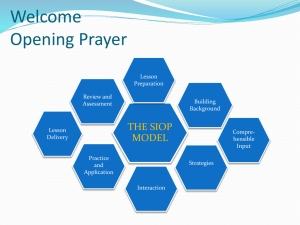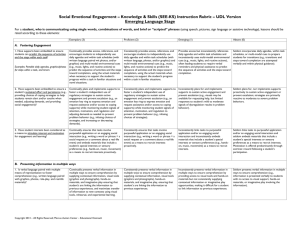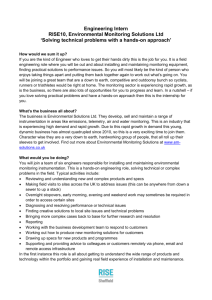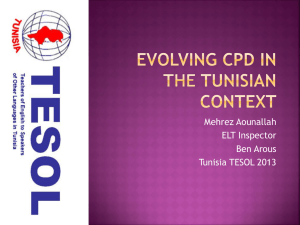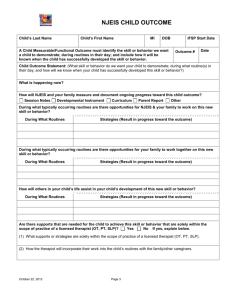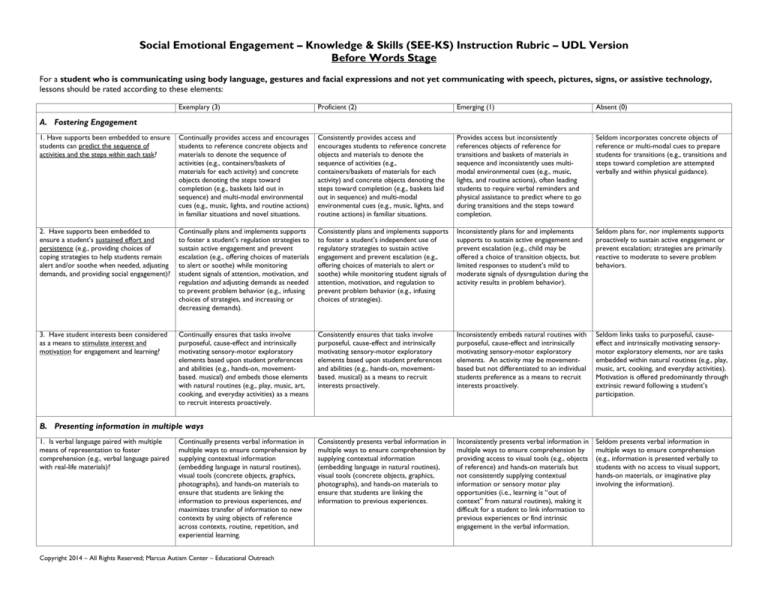
Social Emotional Engagement – Knowledge & Skills (SEE-KS) Instruction Rubric – UDL Version
Before Words Stage
For a student who is communicating using body language, gestures and facial expressions and not yet communicating with speech, pictures, signs, or assistive technology,
lessons should be rated according to these elements:
Exemplary (3)
Proficient (2)
Emerging (1)
Absent (0)
1. Have supports been embedded to ensure
students can predict the sequence of
activities and the steps within each task?
Continually provides access and encourages
students to reference concrete objects and
materials to denote the sequence of
activities (e.g., containers/baskets of
materials for each activity) and concrete
objects denoting the steps toward
completion (e.g., baskets laid out in
sequence) and multi-modal environmental
cues (e.g., music, lights, and routine actions)
in familiar situations and novel situations.
Consistently provides access and
encourages students to reference concrete
objects and materials to denote the
sequence of activities (e.g.,
containers/baskets of materials for each
activity) and concrete objects denoting the
steps toward completion (e.g., baskets laid
out in sequence) and multi-modal
environmental cues (e.g., music, lights, and
routine actions) in familiar situations.
Provides access but inconsistently
references objects of reference for
transitions and baskets of materials in
sequence and inconsistently uses multimodal environmental cues (e.g., music,
lights, and routine actions), often leading
students to require verbal reminders and
physical assistance to predict where to go
during transitions and the steps toward
completion.
Seldom incorporates concrete objects of
reference or multi-modal cues to prepare
students for transitions (e.g., transitions and
steps toward completion are attempted
verbally and within physical guidance).
2. Have supports been embedded to
ensure a student’s sustained effort and
persistence (e.g., providing choices of
coping strategies to help students remain
alert and/or soothe when needed, adjusting
demands, and providing social engagement)?
Continually plans and implements supports
to foster a student’s regulation strategies to
sustain active engagement and prevent
escalation (e.g., offering choices of materials
to alert or soothe) while monitoring
student signals of attention, motivation, and
regulation and adjusting demands as needed
to prevent problem behavior (e.g., infusing
choices of strategies, and increasing or
decreasing demands).
Consistently plans and implements supports
to foster a student’s independent use of
regulatory strategies to sustain active
engagement and prevent escalation (e.g.,
offering choices of materials to alert or
soothe) while monitoring student signals of
attention, motivation, and regulation to
prevent problem behavior (e.g., infusing
choices of strategies).
Inconsistently plans for and implements
supports to sustain active engagement and
prevent escalation (e.g., child may be
offered a choice of transition objects, but
limited responses to student’s mild to
moderate signals of dysregulation during the
activity results in problem behavior).
Seldom plans for, nor implements supports
proactively to sustain active engagement or
prevent escalation; strategies are primarily
reactive to moderate to severe problem
behaviors.
3. Have student interests been considered
as a means to stimulate interest and
motivation for engagement and learning?
Continually ensures that tasks involve
purposeful, cause-effect and intrinsically
motivating sensory-motor exploratory
elements based upon student preferences
and abilities (e.g., hands-on, movementbased. musical) and embeds those elements
with natural routines (e.g., play, music, art,
cooking, and everyday activities) as a means
to recruit interests proactively.
Consistently ensures that tasks involve
purposeful, cause-effect and intrinsically
motivating sensory-motor exploratory
elements based upon student preferences
and abilities (e.g., hands-on, movementbased. musical) as a means to recruit
interests proactively.
Inconsistently embeds natural routines with
purposeful, cause-effect and intrinsically
motivating sensory-motor exploratory
elements. An activity may be movementbased but not differentiated to an individual
students preference as a means to recruit
interests proactively.
Seldom links tasks to purposeful, causeeffect and intrinsically motivating sensorymotor exploratory elements, nor are tasks
embedded within natural routines (e.g., play,
music, art, cooking, and everyday activities).
Motivation is offered predominantly through
extrinsic reward following a student’s
participation.
Consistently presents verbal information in
multiple ways to ensure comprehension by
supplying contextual information
(embedding language in natural routines),
visual tools (concrete objects, graphics,
photographs), and hands-on materials to
ensure that students are linking the
information to previous experiences.
Inconsistently presents verbal information in
multiple ways to ensure comprehension by
providing access to visual tools (e.g., objects
of reference) and hands-on materials but
not consistently supplying contextual
information or sensory motor play
opportunities (i.e., learning is “out of
context” from natural routines), making it
difficult for a student to link information to
previous experiences or find intrinsic
engagement in the verbal information.
Seldom presents verbal information in
multiple ways to ensure comprehension
(e.g., information is presented verbally to
students with no access to visual support,
hands-on materials, or imaginative play
involving the information).
A. Fostering Engagement
B. Presenting information in multiple ways
1. Is verbal language paired with multiple
means of representation to foster
comprehension (e.g., verbal language paired
with real-life materials)?
Continually presents verbal information in
multiple ways to ensure comprehension by
supplying contextual information
(embedding language in natural routines),
visual tools (concrete objects, graphics,
photographs), and hands-on materials to
ensure that students are linking the
information to previous experiences, and
maximizes transfer of information to new
contexts by using objects of reference
across contexts, routine, repetition, and
experiential learning.
Copyright 2014 – All Rights Reserved; Marcus Autism Center – Educational Outreach
2. Are mathematical and other symbols
paired with multiple forms of representation
to ensure access to curricular materials
(e.g., hands-on and/or real-life materials,
multiple media, and role-play)?
3. Are social cues presented in multiple
ways to ensure accurate perception (e.g.,
providing visuals to clarify expectations for
where to sit, how to engage in turn-taking)?
Continually presents mathematical and
other symbols in multiple ways to ensure
comprehension by supplying contextual
information (embedding these symbols in
natural routines such as music, dressing
routines and meals), visual tools (concrete
objects, graphics, photographs), and handson materials to ensure that students are
linking the information to previous
experiences, and maximizes transfer of
information to new contexts by using
objects of reference across contexts,
routine, repetition, and experiential
learning.
Continually presents social cues in multiple
ways to ensure comprehension of
expectations by supplying contextual
information (embedding social cues in
natural routines such as songs, social play,
and meals), visual tools (concrete objects,
graphics, photographs), and hands-on
materials to ensure that students are linking
the information to previous experiences,
and maximizes transfer of information to
new contexts by using objects of reference
across contexts, routine, repetition, and
experiential learning.
Consistently presents mathematical and
other symbols in multiple ways to ensure
comprehension by supplying contextual
information (embedding language in natural
routines), visual tools (concrete objects,
graphics, photographs), and hands-on
materials to ensure that students are linking
the information to previous experiences.
Inconsistently presents mathematical and
other symbols in multiple ways to ensure
comprehension by providing access to visual
tools (objects of reference graphics and
photographs) and hands-on materials but
not consistently supplying contextual
information or sensory motor play
opportunities (i.e., learning is “out of
context” from natural routines), making it
difficult for a student to link information to
previous experiences or find intrinsic
engagement in the verbal information.
Seldom presents mathematical and other
symbols in multiple ways to ensure
comprehension (e.g., information is
presented verbally to students with no
access to graphics or photographs, hands-on
materials, or imaginative play related to
real-life application).
Consistently presents social cues in multiple
ways to ensure comprehension of
expectations by supplying contextual
information (embedding social cues in
natural routines such as songs, social play,
and meals), visual tools (concrete objects,
graphics, photographs), and hands-on
materials to ensure that students are linking
the information to previous experiences.
Inconsistently presents social cues in
multiple ways to ensure comprehension of
expectations by supplying some visual tools
(objects of reference graphics and
photographs) and hands-on materials but
not consistently supplying contextual
information or sensory motor play
opportunities (i.e., learning is “out of
context” from natural routines), making it
difficult for a student to link information to
previous experiences or find intrinsic
engagement in the verbal information.
Seldom presents social cues in multiple
ways to ensure comprehension of
expectations. Response to a student’s
misunderstanding or misuse of social cues is
primarily reactive and consequence-based.
C. Allowing students to act and express themselves in multiple ways
1. Are students provided with
opportunities to independently access
materials in the environment, engage with
others, and reference developmentally
appropriate supports designed to foster
self-determination and self-regulation?
Continually plans and provides options for
students to practice self-regulation by
allowing students to independently access
materials and seek engagement with others
(e.g., objects of reference for transitions,
activity baskets in sequence, choices of
materials in see-thru containers) within
familiar routines and unfamiliar activities.
Consistently plans and provides options for
students to practice self-regulation by
allowing students to independently access
materials and seek engagement with others
(e.g., objects of reference for transitions,
activity baskets in sequence, choices of
materials in see-thru containers) within
familiar routines.
Inconsistently plans and provides options
for students to practice self-regulation by
allowing students to independently access
objects of reference for transitions, but only
occasionally providing choices of materials
to request as a means to access selfregulatory strategies.
Seldom plans and provides options for
students to practice self-regulation.
Students are not encouraged and do not yet
independently access materials (e.g., objects
of reference, activity baskets in sequence,
preferred and regulating materials in seethru containers).
2. Are students provided with multiple
options for expression and communication
sensitive to their developmental level (e.g.,
visual choices of see-thru containers and
objects to represent social request and
activities)?
Continually fosters opportunities for
student expression and communication by
encouraging active learning and interaction
and providing visual supports for key social
language targets for children not yet using
words (e.g., offering choices of desired
materials in see-thru containers to foster
initiations of nonverbal communication) in
both familiar and novel situations.
Continually provides options for students to
use physical action and/or expression to
sustain engagement in activities by varying
the response methods within activity (e.g.,
sitting and attending is paired with engaging
with hands-on materials, movement, and
sensory actions), providing concrete visuals
(the actual materials) to remind the student
of coping strategies for staying alert and
requesting assistance, and monitoring the
students’ signals to adjust demands
accordingly.
Consistently fosters opportunities for
student expression and communication by
encouraging active learning and interaction
and providing visual supports for key social
language targets for children not yet using
words (e.g., offering choices of desired
materials in see-thru containers to foster
initiations of nonverbal communication) in b
familiar situations.
Consistently provides options for students
to use physical action and/or expression to
sustain engagement in activities by varying
the response methods within activity (e.g.,
sitting and attending is paired with engaging
with hands-on materials, movement, and
sensory actions), providing concrete visuals
(the actual materials) to remind the student
of coping strategies for staying alert and
requesting assistance,
Inconsistently fosters opportunities for
student expression and communication by
encouraging, on occasion, interaction but
only occasionally providing visual supports
for key social language targets for children
not yet using words (e.g., offering choices of
desired materials in see-thru containers to
foster initiations of nonverbal
communication)
Inconsistently provides options for students
to use physical action and/or expression to
sustain engagement in activities by providing
some variety of response methods within
lessons (e.g., movements within songs), but
only limited visuals and hands-on materials
to remind the student of coping strategies
for staying alert and requesting assistance.
Seldom fosters opportunities for student
expression and communication; students
remain in passive role most of the activity
and visuals (e.g., objects, see-thru
containers, etc.) are not provided to
encourage gestures or nonverbal
communication.
3. Are students provided with multiple
options for sustaining engagement in
activities (e.g., participating with access to
hands-on materials, with options for using
visuals/written choices, and with assistance
of others as a support)?
Copyright 2014 – All Rights Reserved; Marcus Autism Center – Educational Outreach
Seldom provides options for students to use
physical action and/or expression to sustain
engagement in activities. Student is
expected to engage in the same way
throughout the task (e.g., sitting, attending
and imitating actions) without varying
response opportunities (e.g., engaging with
hands-on materials) as a means to stay
engaged or soothe when distressed.

